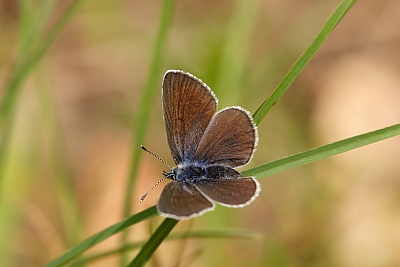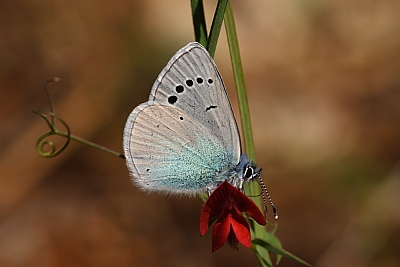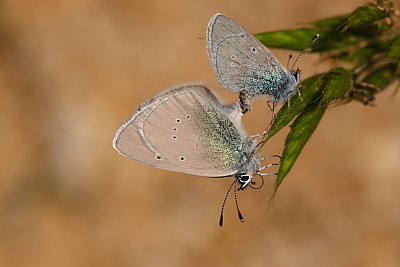

















Green-underside Blue (Glaucopsyche alexis)
2025 photographs highlighted in green. Click on any photograph to go to an enlarged picture, or simply scroll down the page.
|
Alexis is a widespread and quite common early season butterfly, emerging in late April but having largely disappeared in Var by the time July arrives. The underside markings vary quite dramatically; the unh spots can be almost non-existent and the strong unf spots greatly reduced (the books describe this as "variant"), when the female could almost be confused with the Mazarine Blue (Cyaniris semiargus) if the forewing is tucked below the hindwing. The underside colour, as can be seen from these photographs, is also highly variable, and one could be forgiven for thinking that these alexis shots were of several different species. Only occasionally is a female greenish in colour, with a greenish basal sheen, so this species is probably mis-named.
The male upperside has a conspicuous wide black border, widening at the apex; this serves to differentiate the male alexis from any other species (apart from melanops - see opposite) in France. |
The blue colour is quite strong and slightly darker than the Common Blue (Polyommatus icarus), which it resembles in terms of size. The female can vary from almost completely brown to having extensive blue in the basal areas of both forewings.
The Black-eyed Blue (G. melanops) is very similar, the main distinguishing feature being the grey marks around the underside margins of both wings. These can vary between just discernible to quite strong in melanops, so sometimes a good view is needed to confirm their existence. Alexis has no marginal markings, even vestigial, so this is a definitive identification clue.
Melanops is often smaller in size, and the male upperside has, in my opinion, a rather paler steely-blue colouring, although at least one expert does not concur. The melanops black border is not dissimilar to the alexis border but is not quite as neat and tidy. |
| ref | sex |
observations |
alt. m |
| 20235 | M |
the characteristic black borders widen toward the apex. |
650 |
| 32475 | M | a male, perhaps a slightly darker blue than normal. | 1080 |
| 45894 | M | a male, the blue appearing lighter, perhaps a function of the camera angle. | 220 |
| 50574 | M | a male from the eastern Pyrénées showing a very wide black upf border, especially at the apex. 50757 is the underside. | 620 |
| 32071 | F | a female, with only a smattering of blue scales in the basal region of the forewing. | 480 |
| 36945 | F | a female, with a degree of blue scaling intermediate between 32071 and 10235. | 220 |
| 10235 | F |
very limited blue scales in the basal area. |
185 |
| 32476 | M | a male, another example of the variability of the underside of alexis in that the unh is virtually unmarked save for a small spot in s7, and the unf marks are in almost a straight line. | 1080 |
| 14778 | M |
only two or three very vestigial unh spots, unusual but it does happen from time to time. The angle of the shot suggests it has developed a wiggly tail. |
185 |
| 34773 | M | a male, taking salts from the ground. This rather reinforces the observation that alexis normally has very few unh post-discal spots in the PACA region, this one typically having only one, in s7. | 680 |
| 40410 | M | a male, roosting in rather overcast conditions. It is quite a pale blue and has quite pronounced unh spots. | 700 |
| 50757 | M | a male, the underside of 50574. The absence of unh ocelli, apart from the small ocellus in s6, is quite typical for this species. | 620 |
| 50934 | F | a female underside, with unusually large unf black post-discal spots. | 220 |
| 24663 | F | a fairly typical female, in terms of the heaviness of the spotting and the ground colour. | 220 |
| 25562 | PAIR | a mating pair, the female on the right. The female is unusually quite blue, illustrating how variable this species can be. | 1000 |
| 5498 | PAIR |
a mating pair, female below. The male seems fairly normal, albeit with only three smallish unh post-discal spots, but the female is clearly green with a strong basal green flush, and a series of five small unh post-discal spots. I have never seen any alexis to be this clearly green. |
340 |
| 29541 | PAIR | a mating pair, the larger, and pristine, female below, and the male, lightly marked and with a strong basal blue flush, above. It is perhaps surprising that the English name for this species is not Blue-underside Blue. | 185 |
| 42350 | PAIR | yet another mating pair, the bluer male on the left and the rather greener female on the right. | 220 |
20235_male_Alpes-de-Haute-Provence_21May10
32475_male_Alpes-Maritimes_1Jun13
32476_male_Alpes-Maritimes_1Jun13
40410_male_Alpes-de-Haute-Provence_11May16
25562_pair_Alpes-Maritimes_09Jun11